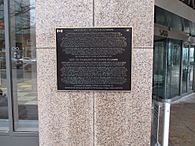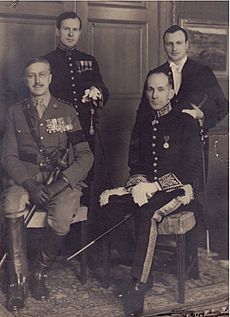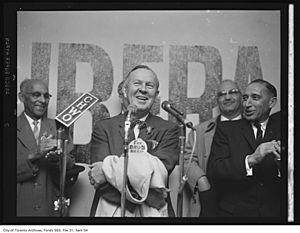Lester B. Pearson facts for kids
Quick facts for kids
Lester B. Pearson
|
|
|---|---|
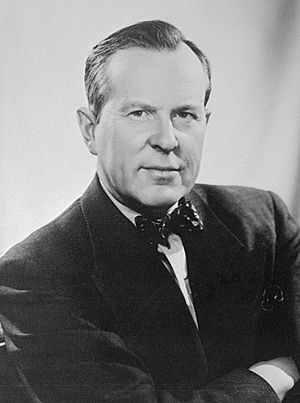
Pearson in 1957
|
|
| 14th Prime Minister of Canada | |
| In office 22 April 1963 – 20 April 1968 |
|
| Monarch | Elizabeth II |
| Governor General | Georges Vanier Roland Michener |
| Preceded by | John Diefenbaker |
| Succeeded by | Pierre Trudeau |
| Leader of the Liberal Party | |
| In office 16 January 1958 – 6 April 1968 |
|
| Preceded by | Louis St. Laurent |
| Succeeded by | Pierre Trudeau |
| Leader of the Opposition | |
| In office 16 January 1958 – 22 April 1963 |
|
| Preceded by | Louis St. Laurent |
| Succeeded by | John Diefenbaker |
| Secretary of State for External Affairs | |
| In office 10 September 1948 – 20 June 1957 |
|
| Prime Minister | W. L. Mackenzie King Louis St. Laurent |
| Preceded by | Louis St. Laurent |
| Succeeded by | John Diefenbaker |
| Ambassador of Canada to the United States | |
| In office July 1944 – September 1946 |
|
| Prime Minister | W. L. Mackenzie King |
| Preceded by | Leighton McCarthy |
| Succeeded by | H. H. Wrong |
| 7th President of the United Nations General Assembly | |
| In office 14 October 1952 – 23 April 1953 |
|
| Preceded by | Luis Padilla Nervo |
| Succeeded by | Vijaya Lakshmi Pandit |
| Member of Parliament for Algoma East |
|
| In office 25 October 1948 – 23 April 1968 |
|
| Preceded by | Thomas Farquhar |
| Succeeded by | Riding abolished |
| Personal details | |
| Born |
Lester Bowles Pearson
23 April 1897 Newtonbrook, Ontario, Canada |
| Died | 27 December 1972 (aged 75) Ottawa, Ontario, Canada |
| Resting place | Maclaren Cemetery, Wakefield, Quebec |
| Political party | Liberal |
| Spouse |
Maryon Moody
(m. 1925) |
| Children | 2, including Geoffrey |
| Education |
|
| Profession |
|
| Awards | Nobel Prize for Peace (1957) |
| Signature | |
| Nickname | Mike |
| Military service | |
| Allegiance | Canada |
| Branch/service |
|
| Years of service | 1915–1918 |
| Rank |
|
| Battles/wars | World War I |
Lester Bowles "Mike" Pearson (born April 23, 1897 – died December 27, 1972) was a very important Canadian leader. He was a scholar, diplomat, and politician. He served as the 14th Prime Minister of Canada from 1963 to 1968.
Pearson was born in Newtonbrook, Ontario. He worked for the Canadian government in foreign affairs. He was Canada's ambassador to the United States from 1944 to 1946. Later, he became the Secretary of State for External Affairs (like a foreign minister) from 1948 to 1957.
In 1957, Pearson won the famous Nobel Peace Prize. He earned this award for helping to solve the Suez Crisis. This was a big international problem, and he helped create the United Nations Emergency Force to keep peace. This made him well-known around the world.
After his party lost the 1957 election, Pearson became the leader of the Liberal Party of Canada in 1958. He became Prime Minister in 1963. During his time as Prime Minister, he led two minority governments. This meant his party didn't have the most seats, so he needed support from other parties to pass laws.
Even with a minority government, Pearson introduced many important programs. These included universal health care, the Canada Student Loan Program, and the Canada Pension Plan. He also introduced the Order of Canada and helped create the Maple Leaf flag in 1965. His government also combined Canada's armed forces and kept Canada out of the Vietnam War. In 1967, Canada became the first country to use a points-based system for immigration.
Pearson is remembered as one of Canada's most important leaders of the 20th century. He is often ranked among the greatest Canadian prime ministers.
Contents
Early Life and Education
Lester Pearson was born in Newtonbrook, Ontario, which is now part of Toronto. His father, Edwin Arthur Pearson, was a minister. Lester had two brothers, Vaughan and Marmaduke. When Lester was young, his family moved to Aurora, Ontario, where his father was a minister. Lester spent his early years there and went to public school.
Pearson finished high school in Hamilton, Ontario, in 1913 when he was 16. He then went to Victoria College at the University of Toronto. He was a very good student, especially in history and psychology. After university, he won a scholarship to study at St John's College, Oxford in England from 1921 to 1923.
Sporting Interests
Pearson was a talented athlete at the University of Toronto. He was excellent at rugby union and also played basketball. While studying at Oxford, he played for the Oxford University Ice Hockey Club. His team won the first Spengler Cup in 1923.
As a young person, Pearson also played baseball and lacrosse. He was good enough at baseball to play semi-pro for a summer. He even toured North America with a lacrosse team made up of players from Oxford and Cambridge Universities. Later, when he taught at the University of Toronto, he helped coach their football and hockey teams. As an adult, he was also a good golf and tennis player.
First World War Service
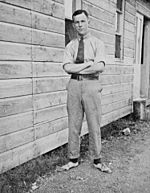
During World War I, Pearson volunteered to serve as a medical orderly. In 1915, he went overseas with the Canadian Army Medical Corps. He was a stretcher-bearer, helping to carry wounded soldiers. He spent almost two years in Southern Europe, including the Salonika front.
In 1917, Pearson became a temporary lieutenant. He then joined Britain's Royal Flying Corps as a flying officer. This is where he got his famous nickname, "Mike." His flight instructor thought "Lester" was too gentle for an airman and said, "That’s a sissy’s name. You’re Mike." From then on, his friends and family always called him Mike.
Pearson learned to fly in England. He survived an airplane crash on his very first flight! In 1918, he was hit by a bus in London during a wartime blackout. He was sent home to recover and then left the service.
Between the Wars
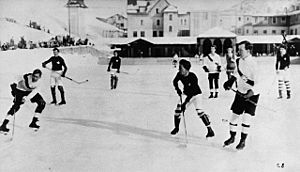
After the war, Pearson went back to school. He earned his Bachelor of Arts degree from the University of Toronto in 1919. He then worked for a year in the meat-packing industry, which he didn't enjoy.
Oxford Studies
Pearson received a scholarship and studied for two more years at St John's College, Oxford. He earned another degree in modern history in 1923. After Oxford, he returned to Canada and taught history at the University of Toronto.
Marriage and Family
In 1925, he married Maryon Moody, who had been one of his students. They had a son, Geoffrey, and a daughter, Patricia. Maryon was a strong and supportive partner throughout his career.
Becoming a Diplomat
In 1927, Pearson started his career in the Canadian foreign service. He scored the highest marks on the entry exam. Prime Minister R. B. Bennett noticed Pearson's talent in the early 1930s. He gave Pearson important roles in government studies and recognized his work with an OBE award. In 1935, Pearson was sent to work at the Canadian High Commission in London, England.
World War II and Beyond
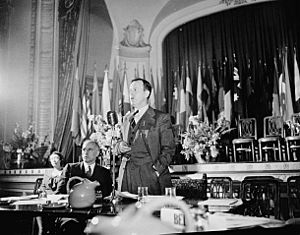
Pearson continued to work in London during World War II. He helped with military supplies and refugee issues. In 1942, he moved to the Canadian Embassy in Washington, D.C. He became the Canadian Ambassador to the United States in 1945.
Pearson played a key role in creating both the United Nations (UN) and the North Atlantic Treaty Organization (NATO). These organizations were formed to promote peace and security after the war.
Pearson was almost chosen to be the first Secretary-General of the United Nations in 1946, but the Soviet Union blocked it. He was also a top candidate in 1953, but again, the Soviet Union said no. Instead, Dag Hammarskjöld from Sweden became the Secretary-General.
Secretary of State for External Affairs (1948-1957)
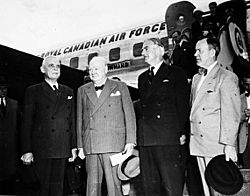
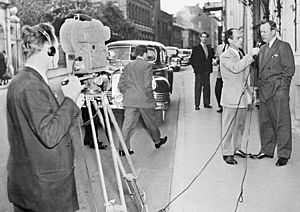
In 1948, Prime Minister William Lyon Mackenzie King appointed Pearson as the Secretary of State for External Affairs. Soon after, Pearson won a seat in the House of Commons of Canada. He served in this role under Prime Minister Louis St. Laurent until 1957.
Nobel Peace Prize for Suez Crisis Role
In 1957, Pearson received the Nobel Peace Prize. He won it for his important work in solving the Suez Crisis in 1956. This crisis involved Egypt, Israel, Britain, and France. Pearson helped create the United Nations Emergency Force (UNEF). This was a peacekeeping force that went to the Suez Canal to stop the fighting.
Pearson and UN Secretary-General Dag Hammarskjöld are seen as the founders of modern peacekeeping. Their efforts helped prevent a bigger war. Pearson's Nobel medal is now displayed at the Canadian Museum of History.
Leading the Liberal Party
After the Liberal government lost the 1957 election, Prime Minister St. Laurent retired. He supported Pearson to take his place. Pearson was elected leader of the Liberal Party in 1958.
In his first session as opposition leader, Pearson asked the new Prime Minister, John Diefenbaker, to let the Liberals govern again. This was because of economic problems. However, Diefenbaker showed a secret Liberal document that made Pearson's request look bad.
Because of this, Pearson's party lost badly in the 1958 election. The Liberals lost many seats, and Diefenbaker's party won a huge majority.
Pearson organized a special "Thinkers' Conference" in 1960. Here, many new ideas were developed that he would later use as Prime Minister.
In the 1962 election, Pearson's Liberals did better, and Diefenbaker's party lost its majority. This meant Diefenbaker now led a minority government.
Pearson then challenged Diefenbaker on whether Canada should accept American nuclear warheads. This led to a new election in 1963. The Liberals won 129 seats, just short of a majority. With support from some other Members of Parliament, Pearson was able to form a minority government. He became Prime Minister on April 22, 1963.
Prime Minister (1963–1968)
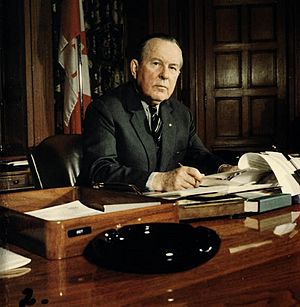
Pearson never had a majority government, but he introduced many important social programs for Canadians.
Key Domestic Policies
- Universal Health Care: Pearson's government helped create universal health care, which means everyone can get medical care.
- Canada Pension Plan: He also introduced the Canada Pension Plan, which helps people save for retirement.
- Canada Student Loans: This program helps students pay for their education.
- New Canadian Flag: Pearson led the country through the Great Canadian flag debate. In 1965, Canada adopted its current Maple Leaf flag.
- Worker Rights: He introduced a 40-hour work week, two weeks of vacation, and a new minimum wage for some workers.
- Official Bilingualism: Pearson started a study on bilingualism and biculturalism. This led to French becoming an official language in Canada, alongside English. He hoped to be the last Prime Minister who spoke only one language.
- Immigration System: In 1967, his government created a new points-based immigration system. This made Canada the first country to encourage immigration based on skills, not origin.
- Centennial Celebrations: Pearson oversaw Canada's 100th birthday celebrations in 1967.
Foreign Policy
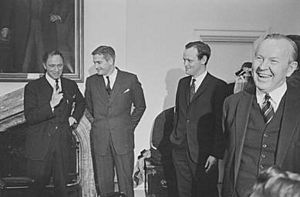
In 1964, Pearson became the first Canadian Prime Minister to visit France officially.
In 1967, French President Charles de Gaulle visited Quebec. He made a controversial speech, saying "Vive le Québec libre" (Long live free Quebec), which suggested support for Quebec separating from Canada. Pearson was very angry. He publicly told de Gaulle that "Canadians do not need to be liberated" and that he was no longer welcome.
Pearson signed the Canada–United States Automotive Products Agreement (Auto Pact) in 1965. This agreement helped the car industry in both countries.
Pearson's government decided not to send Canadian combat troops to the Vietnam War, even though the U.S. asked for help. He spoke in Philadelphia in 1965, suggesting a pause in American bombing to find a peaceful solution. This upset U.S. President Lyndon B. Johnson, but they later met and continued to have contact.
Military Changes
Pearson's government made a big change to Canada's military. In 1968, the Royal Canadian Navy, the Royal Canadian Air Force, and the Canadian Army were combined into one service called the Canadian Forces.
Supreme Court Appointments
Pearson chose several judges to be appointed to the Supreme Court of Canada. These included Robert Taschereau and John Robert Cartwright as Chief Justices.
Retirement from Politics
Pearson announced his retirement from politics on December 14, 1967. His successor as Liberal leader and Prime Minister was Pierre Trudeau. Pearson had encouraged Trudeau to enter politics and made him justice minister. Two other cabinet ministers Pearson recruited, John Turner and Jean Chrétien, also later became prime ministers.
After Being Prime Minister
After retiring, Pearson worked as chairman of the Commission on International Development from 1968 to 1969. He also lectured at Carleton University in Ottawa and began writing his memoirs. From 1970 to 1972, he was the first chairman of the Board of Governors of the International Development Research Centre. He was also the chancellor of Carleton University until his death.
Pearson planned to write three books about his life, called "Mike: The Memoirs of the Rt. Hon. Lester B. Pearson". The first book was published in 1972. The other two were published after he passed away.
Illness and Death
In 1970, Pearson had surgery to remove his right eye due to a tumor.
In November 1972, his health worsened. He tried to write about his time as Prime Minister, but his condition quickly got worse around Christmas.
Lester B. Pearson died on December 27, 1972, at his home in Ottawa. The cancer had spread to his liver.
Pearson is buried at Maclaren Cemetery in Wakefield, Quebec.
Honours and Awards
Pearson received many honours and awards throughout his life:
- He was elected an honorary member of the American Academy of Arts and Sciences in 1957.
- The Canadian Press named him "Newsmaker of the Year" nine times, which was a record.
- He was inducted into the Canadian Peace Hall of Fame in 2000.
- The Pearson Medal of Peace is awarded every year to a Canadian who has contributed to international service.
- A plaque marks his birthplace in Newtonbrook, Toronto.
- Canadian historians often rank Pearson among the greatest Canadian prime ministers.
Places Named After Pearson
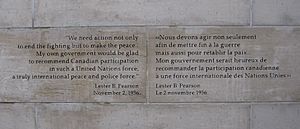
Many places and institutions are named in his honour:
- The Lester B. Pearson United World College in British Columbia, opened in 1974.
- The Pearson Peacekeeping Centre, which provides training on peace operations.
- The Lester B. Pearson School Board, a large English-language school board in Quebec.
- Several high schools and elementary schools across Canada.
- Mike's Place, a student pub at Carleton University, is named after him.
Civic and Other Infrastructure
- Toronto Pearson International Airport, Canada's busiest airport, was renamed in his honour in 1984.
- The Lester B. Pearson Building in Ottawa is the headquarters for Global Affairs Canada.
- The Lester B. Pearson Civic Centre in Elliot Lake, Ontario.
- The Lester B. Pearson Garden for Peace and Understanding at the University of Toronto.
- Lester B. Pearson Place, an affordable housing building in Newtonbrook, Toronto.
- Lester B. Pearson Park in St. Catharines, Ontario.
- Pearson Avenue in Richmond Hill, Ontario, and Pearson Way in Milton, Ontario.
- Pearson Plaza, a mall in Elliot Lake.
- Pearson Park, a playground in Wesleyville, Newfoundland.
Sports Honours
- The award for the best National Hockey League player, voted by players, was called the Lester B. Pearson Award from 1971 to 2010.
- Pearson was inducted into the Sports Hall of Fame at the University of Toronto in 1987.
- He was inducted into the Canadian Baseball Hall of Fame in 1983.
- The Pearson Cup was a baseball competition between the Toronto Blue Jays and Montreal Expos. Pearson was also the Expos' Honorary Club President.
Honorary Degrees
Pearson received many honorary degrees from universities around the world, recognizing his achievements.
| Location | Date | School | Degree |
|---|---|---|---|
| 1945 | University of Toronto | Doctor of Laws (LL.D) | |
| 1947 | University of Rochester | Doctor of Laws (LL.D) | |
| May 1948 | McMaster University | Doctor of Laws (LL.D) | |
| 1 June 1951 | Bates College | Doctor of Laws (LL.D) | |
| 1953 | Harvard University | Doctor of Laws (LL.D) | |
| 1956 | Princeton University | Doctor of Laws (LL.D) | |
| 25 September 1958 | University of British Columbia | Doctor of Laws (LL.D) | |
| 9 June 1963 | University of Notre Dame | Doctor of Laws (LL.D) | |
| 29 May 1964 | University of Western Ontario | Doctor of Laws (LL.D) | |
| September 1964 | Memorial University of Newfoundland | Doctor of Laws (LL.D) | |
| December 1964 | Waterloo Lutheran University | Doctor of Laws (LL.D) | |
| 1964 | Johns Hopkins University | Doctor of Laws (LL.D) | |
| 1965 | Laurentian University | Doctor of Laws (LL.D) | |
| 17 May 1965 | University of Saskatchewan (Regina Campus) | Doctor of Civil Law (DCL) | |
| 28 May 1965 | McGill University | Doctor of Laws (LL.D) | |
| 1965 | Queen's University | Doctor of Laws (LL.D) | |
| 1967 | Dalhousie University | Doctor of Laws (LL.D) | |
| 29 March 1967 | University of Calgary | ||
| 1967 | Prince of Wales College | ||
| 1967 | University of California, Santa Barbara | ||
| 1967 | University of Ottawa | Doctor of Political Science | |
| 22 May 1971 | Royal Military College of Canada | Doctor of Laws (LL.D) | |
| Columbia University | |||
| University of Oxford | Doctor of Civil Law (DCL) |
Freedom of the City
- 1967: London
See also
 In Spanish: Lester Bowles Pearson para niños
In Spanish: Lester Bowles Pearson para niños
- List of prime ministers of Canada
- Canada and the Vietnam War
- Great Canadian Flag Debate
- Landon Pearson
- Canada and the United Nations


